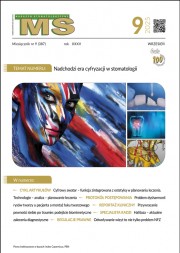Dostęp do tego artykułu jest płatny.
Zapraszamy do zakupu!
Cena: 24.00 PLN (z VAT)
Kup artykuł
Po dokonaniu zakupu artykuł w postaci pliku PDF prześlemy bezpośrednio pod twój adres e-mail.
MS 2022; 7/8: 18-28.
Ultrakrótkie implanty jako skuteczna alternatywa w sytuacji niepowodzenia zabiegu augmentacyjnego – opis przypadku
Ultrashort implants as an effective alternative in the event of failure of augmentation surgery – case report
Damian Dudek, Karolina Wałach, Oliwia Warmusz, Edyta Reichman-Warmusz
Streszczenie
Autorzy przedstawili przypadek zastosowania ultrakrótkich implantów systemu Bicon w bocznym odcinku szczęki, w warunkach znacznego deficytu kości. Jako pierwszy sposób postępowania przeprowadzono zabieg typu sinus lift techniką otwartą, z dostępu bocznego. Po 6 miesiącach obserwacji doszło do całkowitej utraty granulatu kostnego. Według autorów ultrakrótkie implanty Bicon pozwalają na optymalne wykorzystanie dostępnej masy kostnej wyrostka zębodołowego szczęk, jak w opisanym przypadku niepowodzenia procedury augmentacyjnej. Autorzy uważają ponadto, iż użycie tych właśnie implantów w pewnych ściśle określonych warunkach anatomicznych może stanowić korzystną, znacznie mniej inwazyjną i bardziej przewidywalną klinicznie alternatywę dla zabiegów rekonstrukcyjnych w obrębie kości szczękowych.
Abstract
The authors would like to present a case of using ultrashort Bicon implants in the lateral part of the jaw, in conditions of a significant bone deficit. The first procedure was a sinus lift procedure using the open technique, from the lateral approach. After a 6-month follow-up period, the bone granulate was completely lost. According to the authors, the ultra-short Bicon implants allow for the optimal use of the available bone mass of the alveolar process of the jaws, as in the described case of failure of the augmentation procedure. The authors also believe that the use of these implants in certain well-defined anatomical conditions may be a beneficial, much less invasive and more clinically predictable alternative to reconstructive procedures within the jaw bones.
Hasła indeksowe: ultrakrótkie implanty, zanik pionowy kości, niepowodzenie sinus lift
Key words: ultrashort implants, vertical bone loss, sinus lift failure
Ultrashort implants as an effective alternative in the event of failure of augmentation surgery – case report
Damian Dudek, Karolina Wałach, Oliwia Warmusz, Edyta Reichman-Warmusz
Streszczenie
Autorzy przedstawili przypadek zastosowania ultrakrótkich implantów systemu Bicon w bocznym odcinku szczęki, w warunkach znacznego deficytu kości. Jako pierwszy sposób postępowania przeprowadzono zabieg typu sinus lift techniką otwartą, z dostępu bocznego. Po 6 miesiącach obserwacji doszło do całkowitej utraty granulatu kostnego. Według autorów ultrakrótkie implanty Bicon pozwalają na optymalne wykorzystanie dostępnej masy kostnej wyrostka zębodołowego szczęk, jak w opisanym przypadku niepowodzenia procedury augmentacyjnej. Autorzy uważają ponadto, iż użycie tych właśnie implantów w pewnych ściśle określonych warunkach anatomicznych może stanowić korzystną, znacznie mniej inwazyjną i bardziej przewidywalną klinicznie alternatywę dla zabiegów rekonstrukcyjnych w obrębie kości szczękowych.
Abstract
The authors would like to present a case of using ultrashort Bicon implants in the lateral part of the jaw, in conditions of a significant bone deficit. The first procedure was a sinus lift procedure using the open technique, from the lateral approach. After a 6-month follow-up period, the bone granulate was completely lost. According to the authors, the ultra-short Bicon implants allow for the optimal use of the available bone mass of the alveolar process of the jaws, as in the described case of failure of the augmentation procedure. The authors also believe that the use of these implants in certain well-defined anatomical conditions may be a beneficial, much less invasive and more clinically predictable alternative to reconstructive procedures within the jaw bones.
Hasła indeksowe: ultrakrótkie implanty, zanik pionowy kości, niepowodzenie sinus lift
Key words: ultrashort implants, vertical bone loss, sinus lift failure
PIŚMIENNICTWO
- Marincola M, Perpetuini AP, Carelli S i wsp. Time proven clinical success of the SHORT™ implant. Implants. 2013; 1: 38-40.
- Maciejewska K. Analiza kliniczna zalet implantów BICON w wybranych przypadkach. Implants. 2012; 4: 32-36.
- Maciejewska K. Krótki implant Bicon w atroficznym odcinku wyrostka zębodołowego szczęki – opis przypadku. Implants 2013; 2: 28-30.
- Lombardo G, Pighi J, Marincola M i wsp. Cumulative success rate of short and ultrashort implants supporting single crowns in the posterior maxilla. A 3-year retrospective study. Int J Dent. 2017; 2017:
- Marincola M. Ubytki w kościach szczęk i ich konsekwencje w implantologii stomatologicznej. Implants. 2016; 1: 12-16.
- Lombardo G, Marincola M, Signoriello A i wsp. Single-crown, short and ultra-short implants, in association with simultaneous internal sinus lift in the atrophic posterior maxilla. A three-year retrospective study. 2020; 13(9): 2208.
- Al-Hashedi AA, Taiyeb-Ali TB, Yunus N. Outcomes of placing short implants in the posterior mandible. A preliminary randomized controlled trial. Aust Dent J. 2016; 61(2): 208-218.
- Urdaneta RA, Daher S, Leary J i wsp. The survival of ultrashort locking-taper implants. Int J Oral Maxillofac Implants. 2012; 27(3): 644-654.
- Ewers R. The incisal foramen as a means of insertion for one of three ultra-short implants to support a prosthesis for a severely atrophic maxilla – a short-term report. 2018; 4(12): e01034.
- May MC, Andrews PN, Daher S i wsp. Prospective cohort study of dental implant success rate in patients with AIDS. Int J Implant Dent. 2016; 2(1): 20.














